Bundaberg is a provincial city, 280 km. north of Brisbane, or 370 km. by road. It is on the Burnett River, about 12 km.upstream of where the river enters Hervey Bay, and 70 km. north of Maryborough.
The name comes from “Bunda”, an Aboriginal name bestowed, according to one versions, on an assistant surveyor in the district. The other versions is that Bunda is a reference to the local Aboriginal family or tribe. In any event the name Bundaberg was given by District surveyor, J.C. Thompson, in 1868.
Cattle and sheep grazing were taken up in the Wide Bay – Burnett districtin the late 1840s, and tallow became a considerable by-product. Timber was needed for tallow casks. In 1866 John and Gavin Steuart, with interestsin both timber and tallow, took up a selection near the site of the North Bundaberg railway station, having been attracted by an abundance of commercial trees on the banks of the Burnett River. Their selection carried a requirementto plant sugar and coffee, which they did. The following year the Burnett River was proved navigable, a saw mill was established, further agricultural selections were taken up and Bundaberg town was surveyed. In 1875 The Australian Handbook described Bundaberg as –
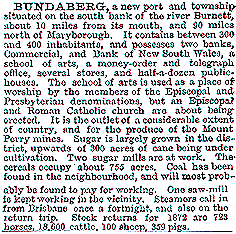
– Click on the entry above to read full text –
By 1880 there were six sugar mills in the Bundaberg region, the firsthaving begun in 1872. The plantation labour was augmented by the importationof Pacific Islands Natives, their population rising from 200 in 1879 to 2,300 in the 1980s. North Bundaberg, where the Steurts had settled, was smaller than South Bundaberg on the opposite side of the Burnett River. They were connected by a river ferry, and North Bundaberg connected inland by a railway to the Mount Perry mining district. (A railway bridge across the river was built in 1891 and a railway link to Brisbane made in 1987.)
In 1880 there were steamer services to Rockhampton, and timber was sent as far north as Cooktown. Churches, schools, friendly societies, banks anda shopping centre had been established. Two years before the Bundaberg municipal borough had been created. Sugar and maize were the main crops. Bundaberg had fifteen sugar refineries – the Millaquin being Queensland’s largest- and refined sugar and molasses were overtaking maize as the main export.By 1904 the Bundaberg census district was approaching a population of 10,000 and The Australian Handbook’s description was –
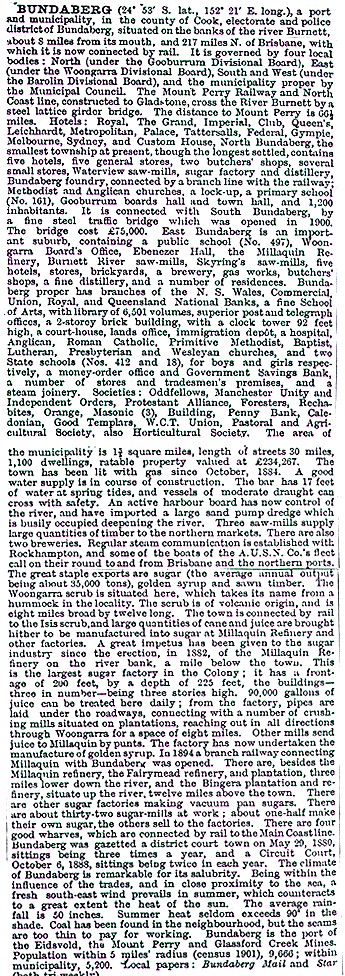
In 1892 Bundaberg’s most famous son and daughter, Bert Hinkler and Gladys Montcrieff, were born. Hinkler became a prominent aviator in Australia and overseas, dying in an air crash in the Italian Alps in 1933. Montcrieff had her stage debut when six at Bundaberg’s Queen’s Theatre. She achieved Australian fame as a soprano as well as undertaking successful overseas tours. Her last public preformance was on Brisbane television in 1962. Bundaberg’s Montcrieff Theatre was opened in 1986.
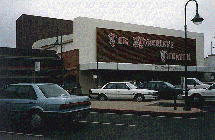
Bundaberg was proclaimed a city on 20 November, 1913, about the same time as it obtained a high school. Sugar growing, refining and distillery products, remained as economic mainstay, and inadequate rail and port facilities inhibited access to markets. The Australian Blue Book 1949 described Bundaberg-
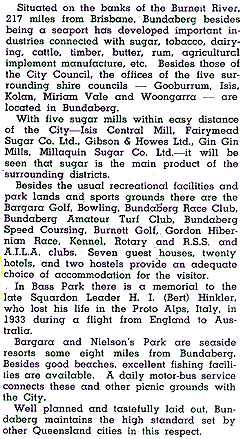
During the 1950s and 1960s Bundaberg had unprecedented growth. The uncertainties of dry years and Burnett River floods were mitigated by irrigation works,and a deep-water port was constructed downstream from Bundaberg’s old wharves.The port has a bulk sugar terminal.
In addition to North Bundaberg there were several suburbs south of the Burnett River – Kepnolk, Norvale and Walkervale, as well as East West and South Bundaberg. In 1986 the Council began a botanic gardens, where the Hinkler house memorial Museam and Fairymead House Sugar Museum are located.
Manufacturing industry diversified beyond the foundaries for sugar mill equipment, and in the 1980s an Aloe Vera growing and processing site was begun. By 1995 it had a substantial export market. Bundaberg has an ArtsCentre, a campus of the Central Queensland University, TAFE, eight secondary schools, twelve primary schools, three hospitals, two nursing homes and three retirements villages.In 1994 Bundaberg city’s boundaries were extended, adding 6,000 people and 43 sq. km. to its previous 45 sq. km. Residents from neighbouring Isis, Nolah and Burnett Shires commute to Bundaberg for employment and other activities.
Bundaberg’s census populations have been 5,516(1911), 11,466 (1933), 19,951 (1954), 27,324 (1971), and 32,737 (1991).In 1994, the estimated population of the enlarged municipality was 44,000.
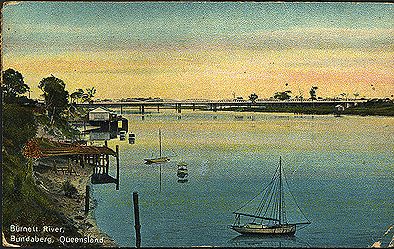
Burnett River and bridge. Postcard dated April 1913.

Bundaberg’s modernity was a source of pride.



